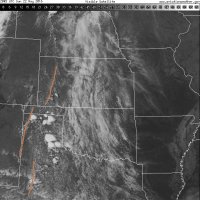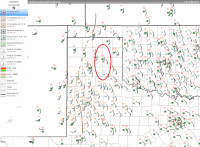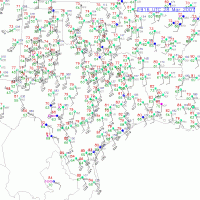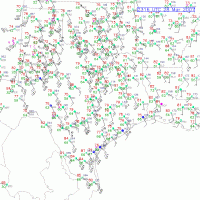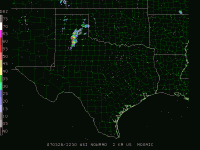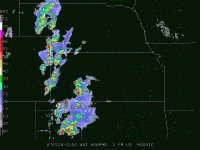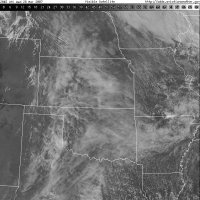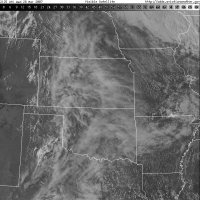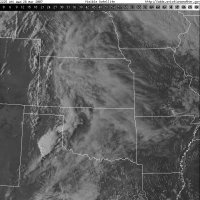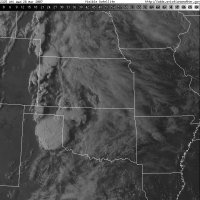Greg Flint
EF1
I found myself chasing for the 3rd year in a row, (Im a MA/RI resident so it takes serious planning) but I definitely hit the jackpot this year. I was able to correctly position myself underneath the Leoti KS Supercell (amazing structure) and witness multiple tornados near Spearman/ Perryton in the TX panhandle the following day. I'd like to think the DVDs and books I spent the last year watching/studying helped tremendously, but I can't help but feel I got very lucky as well (especially Sunday where there were multiple tornado warned cells and I could have busted bigtime).
Anyway, as I still digest my chase experience, i am making different observations and comparing the Saturday chase vs. Sunday chase. Both days storm(s) fired along the dryline, with extremely slow storm motion which is welcome by this amateur On the Leoti KS supercell from Saturday, I recall the Supercell's motion was tracking to the northeast until it eventually became stationary as it got later in the evening. Closer to dark after it put down a few short lived tornadoes, the motion actually seemed to drift to the South south east. It was the only cell in the area so I gather it wasn't being interfered with at all. This cell seemed to have surface winds feeding it from the south all day, but they eventually just stopped for a good 20-30 mins, not sure how/why the surface winds were cut off like that or if that played a role in eventual motion to the southeast. We were stationary for a good hour or two on that cell, so I can comfortably say the surfaced winds seemed to stop for an extended period prior to the cell drifting southeast (slightly).
On the Leoti KS supercell from Saturday, I recall the Supercell's motion was tracking to the northeast until it eventually became stationary as it got later in the evening. Closer to dark after it put down a few short lived tornadoes, the motion actually seemed to drift to the South south east. It was the only cell in the area so I gather it wasn't being interfered with at all. This cell seemed to have surface winds feeding it from the south all day, but they eventually just stopped for a good 20-30 mins, not sure how/why the surface winds were cut off like that or if that played a role in eventual motion to the southeast. We were stationary for a good hour or two on that cell, so I can comfortably say the surfaced winds seemed to stop for an extended period prior to the cell drifting southeast (slightly).
Looking back on the following day (Sunday in the TX panhandle), cells fired along the dryline and moved northeast from inception until almost exactlty the same part of the day as Saturday. We saw a 2nd tornado around 7:45pm while positioned on 281 east of Spearman but the cell/tornado which was located to our North seemed to being heading to the southeast. The following few hours until dark the cell seemed to track to the southeast with inflow screaming in from the north.
Thank you for making it this far, and I understand this is probably painful for some of you to read due to my novice/amateur knowledge I'm displaying, but my question is this...Why did the storm's motion eventually begin tracking to the southeast, and was it a complete coincidence that around the same time in the day each cell began drifting to the southeast? Was this expected by other chasers/meteorologists, or did it catch anyone by surprise? I viewed some Youtube footage from T. Laubach who seemed to have same view as myself, and I noticed 2 white tour vans and a 3rd vehicle who looked like they could reach out and touch the mult-vortex tornado, so maybe they were also expecting the cell to keep moving Northeast as well. See minute mark 1:25 mark obviously this is NOT MY VIDEO:
Anyway, I would appreciate anyone's comments on how their chase unfolded these two days, and if the Tornado south of Perryton and the Southeast motion caught any chasers by surprise. Thoughts on why both days eventually ended with motion heading southeast would also be appreciated.
Thanks
Anyway, as I still digest my chase experience, i am making different observations and comparing the Saturday chase vs. Sunday chase. Both days storm(s) fired along the dryline, with extremely slow storm motion which is welcome by this amateur
Looking back on the following day (Sunday in the TX panhandle), cells fired along the dryline and moved northeast from inception until almost exactlty the same part of the day as Saturday. We saw a 2nd tornado around 7:45pm while positioned on 281 east of Spearman but the cell/tornado which was located to our North seemed to being heading to the southeast. The following few hours until dark the cell seemed to track to the southeast with inflow screaming in from the north.
Thank you for making it this far, and I understand this is probably painful for some of you to read due to my novice/amateur knowledge I'm displaying, but my question is this...Why did the storm's motion eventually begin tracking to the southeast, and was it a complete coincidence that around the same time in the day each cell began drifting to the southeast? Was this expected by other chasers/meteorologists, or did it catch anyone by surprise? I viewed some Youtube footage from T. Laubach who seemed to have same view as myself, and I noticed 2 white tour vans and a 3rd vehicle who looked like they could reach out and touch the mult-vortex tornado, so maybe they were also expecting the cell to keep moving Northeast as well. See minute mark 1:25 mark obviously this is NOT MY VIDEO:
Anyway, I would appreciate anyone's comments on how their chase unfolded these two days, and if the Tornado south of Perryton and the Southeast motion caught any chasers by surprise. Thoughts on why both days eventually ended with motion heading southeast would also be appreciated.
Thanks

